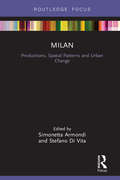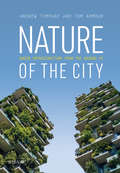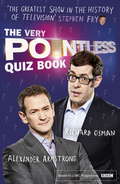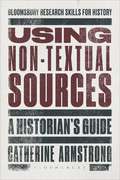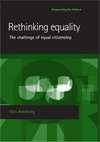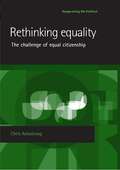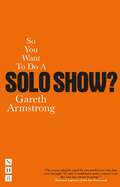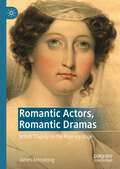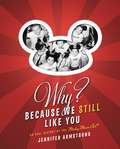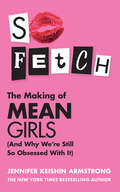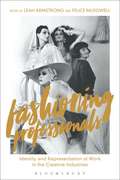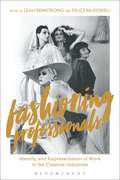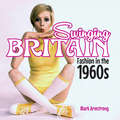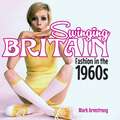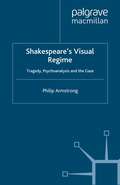- Table View
- List View
Milan: Productions, Spatial Patterns and Urban Change (Built Environment City Studies)
by Simonetta Armondi Stefano Di VitaAs a main urban centre of one of the most dynamic European regions, Milan is a key location from which to study narratives of innovations and contemporary productions – old and new manufacturing, tertiary and consumptive sectors, creative and cultural economy – and investigate their influence both on spatial patterns and urban policy agenda. Accordingly, this book explores the contentious geographies of innovation, productions and working spaces, both empirically and theoretically in a city that, since the beginning of the 2000s, has been involved in a process of urban change, with relevant spatial and socio-economic effects, within an increasingly turbulent world economy. Through this analysis, the book provides an insight into the complexity of contemporary urban phenomena beyond a traditional metropolitan lens, highlighting issues such as rescaling, urban decentralization and recentralization, extensive urban transformation and shrinkage and molecular urban regeneration. This book is a valuable resource for academics, researchers and scholars focusing on Urban Studies such as Urban Policy, Urban Planning, Urban Geography, Urban Economy and Urban Sociology.
Milan: Productions, Spatial Patterns and Urban Change (Built Environment City Studies)
by Simonetta Armondi Stefano Di VitaAs a main urban centre of one of the most dynamic European regions, Milan is a key location from which to study narratives of innovations and contemporary productions – old and new manufacturing, tertiary and consumptive sectors, creative and cultural economy – and investigate their influence both on spatial patterns and urban policy agenda. Accordingly, this book explores the contentious geographies of innovation, productions and working spaces, both empirically and theoretically in a city that, since the beginning of the 2000s, has been involved in a process of urban change, with relevant spatial and socio-economic effects, within an increasingly turbulent world economy. Through this analysis, the book provides an insight into the complexity of contemporary urban phenomena beyond a traditional metropolitan lens, highlighting issues such as rescaling, urban decentralization and recentralization, extensive urban transformation and shrinkage and molecular urban regeneration. This book is a valuable resource for academics, researchers and scholars focusing on Urban Studies such as Urban Policy, Urban Planning, Urban Geography, Urban Economy and Urban Sociology.
Nature of the City: Green Infrastructure from the Ground Up
by Tom Armour Andrew TempanyThis is a practical guide to delivering green infrastructure from the ground up and bringing nature in to the built environment. Exploring the process of delivery through an array of design approaches and case studies, it demystifies the concept and provides the tools for practical implementation - highlighting the challenges and opportunities on both small and large projects.
Nature of the City: Green Infrastructure from the Ground Up
by Tom Armour Andrew TempanyThis is a practical guide to delivering green infrastructure from the ground up and bringing nature in to the built environment. Exploring the process of delivery through an array of design approaches and case studies, it demystifies the concept and provides the tools for practical implementation - highlighting the challenges and opportunities on both small and large projects.
The Very Pointless Quiz Book: Prove your Pointless Credentials (Pointless Books #3)
by Alexander Armstrong Richard OsmanLet hosts Alexander Armstrong and Richard Osman guide you through the quiz rounds with their trademark warmth and humour and battle it out against your friends and family for Pointless glory. Perfect for playing along alone or with family and friends, The Very Pointless Quiz Book will test your knowledge and tease your brains.So how good are you at Pointless? Really? Do you think you've got enough in-depth knowledge of Regional Railways, African Countries With No Coastline and Types of Lettuce to carry off the coveted Pointless trophy?Well let's see shall we?Here's your chance to step up to the podium (metaphorically speaking of course, chances are you'll be sitting somewhere very comfortably with either a mug of tea or a roll of Andrex within easy reach) put that knowledge to the test, and see just how far you can go in a genuine four-round Pointless ordeal.Right, if everyone's ready, let's play Pointless...
Using Non-Textual Sources: A Historian's Guide (Bloomsbury Research Skills for History)
by Catherine ArmstrongUsing Non-Textual Sources provides history students with the theoretical background and skills to interpret non-textual sources. It introduces the full range of non-textual sources used by historians and offers practical guidance on how to interpret them and incorporate them into essays and dissertations. In addition to this, the book posits a theoretical framework that justifies the use of these items as historical sources and explains how they can be used to further understand the past.There is coverage of the creation, production and distribution of non-textual sources; the acquisition of skills to 'read' these sources analytically; and the meaning, significance and reliability of these forms of evidence. Using Non-Textual Sources includes a section on interdisciplinary non-textual source work, outlining what historians borrow from disciplines such as art history, archaeology, geography and media studies, as well as a discussion of how to locate these resources online and elsewhere in order to use them in essays and dissertations.Case studies, such as the Tudor religious propaganda painting Edward VI and the Pope, the 1954 John Ford Western The Searchers and the Hereford Mappa Mundi, are employed throughout to illustrate the functions of main source types. Photographs, cartoons, maps, artwork, audio clips, film, places and artifacts are all explored in a text that provides students with a comprehensive, cohesive and practical guide to using non-textual sources.
Using Non-Textual Sources: A Historian's Guide (Bloomsbury Research Skills for History)
by Catherine ArmstrongUsing Non-Textual Sources provides history students with the theoretical background and skills to interpret non-textual sources. It introduces the full range of non-textual sources used by historians and offers practical guidance on how to interpret them and incorporate them into essays and dissertations. In addition to this, the book posits a theoretical framework that justifies the use of these items as historical sources and explains how they can be used to further understand the past.There is coverage of the creation, production and distribution of non-textual sources; the acquisition of skills to 'read' these sources analytically; and the meaning, significance and reliability of these forms of evidence. Using Non-Textual Sources includes a section on interdisciplinary non-textual source work, outlining what historians borrow from disciplines such as art history, archaeology, geography and media studies, as well as a discussion of how to locate these resources online and elsewhere in order to use them in essays and dissertations.Case studies, such as the Tudor religious propaganda painting Edward VI and the Pope, the 1954 John Ford Western The Searchers and the Hereford Mappa Mundi, are employed throughout to illustrate the functions of main source types. Photographs, cartoons, maps, artwork, audio clips, film, places and artifacts are all explored in a text that provides students with a comprehensive, cohesive and practical guide to using non-textual sources.
Rethinking equality: The challenge of equal citizenship (PDF) (Reappraising the Political)
by Chris ArmstrongAlthough formally equal, relations between citizens are actually characterised by many and varied forms of inequality. Do contemporary theories of equality provide an adequate response to the inequalities that afflict contemporary societies? And what is the connection between theories of equality and the contemporary politics of citizenship? Accessible and comprehensive, Rethinking equality provides a clear, critical and very up-to-date account of the most important contemporary egalitarian theories. Unusually, it also relates these theories to contemporary political practice, assessing them in relation to the impact of neoliberalism on contemporary welfare states, and the shift from ‘social’ to ‘active’ forms of citizenship. As well as representing a significant intervention within academic debates on equality and citizenship, this book represents essential reading for students of contemporary political theory.
Rethinking equality: The challenge of equal citizenship (Reappraising the Political)
by Chris ArmstrongAlthough formally equal, relations between citizens are actually characterised by many and varied forms of inequality. Do contemporary theories of equality provide an adequate response to the inequalities that afflict contemporary societies? And what is the connection between theories of equality and the contemporary politics of citizenship? Accessible and comprehensive, Rethinking equality provides a clear, critical and very up-to-date account of the most important contemporary egalitarian theories. Unusually, it also relates these theories to contemporary political practice, assessing them in relation to the impact of neoliberalism on contemporary welfare states, and the shift from ‘social’ to ‘active’ forms of citizenship. As well as representing a significant intervention within academic debates on equality and citizenship, this book represents essential reading for students of contemporary political theory.
Romantic Actors, Romantic Dramas: British Tragedy on the Regency Stage
by James ArmstrongThis book reinterprets British dramas of the early-nineteenth century through the lens of the star actors for whom they were written. Unlike most playwrights of previous generations, the writers of British Romantic dramas generally did not work in the theatre themselves. However, they closely followed the careers of star performers. Even when they did not directly know actors, they had what media theorists have dubbed "para-social interactions" with those stars, interacting with them through the mediation of mass communication, whether as audience members, newspaper and memoir readers, or consumers of prints, porcelain miniatures, and other manifestations of "fan" culture. This study takes an in-depth look at four pairs of performers and playwrights: Sarah Siddons and Joanna Baillie, Julia Glover and Samuel Taylor Coleridge, Edmund Kean and Lord Byron, and Eliza O'Neill and Percy Bysshe Shelley. These charismatic performers, knowingly or not, helped to guide the development of a character-based theatre—from the emotion-dominated plays made popular by Baillie to the pinnacle of Romantic drama under Shelley. They shepherded in a new style of writing that had verbal sophistication and engaged meaningfully with the moral issues of the day. They helped to create not just new modes of acting, but new ways of writing that could make use of their extraordinary talents.
Why? Because We Still Like You: An Oral History of the Mickey Mouse Club(R)
by Jennifer ArmstrongFrom the bestselling author of Sienfeldia, a behind-the-scenes history of the Mickey Mouse Club that is a treat for anyone who grew up with Walt Disney's television classic.Full of nostalgia, this book gives you the never before told story of how The Mickey Mouse Club paved the way for all that came after, from its humble beginnings as a marketing ploy, through its short but mesmerizing run, to the numerous resurrections that made it one of television's first true cult hits--all through the recollections of those regular kids-turned-stars who made it a phenomenon. It will reveal, for the first time ever, the stories of Annette, Darlene (and her famous rivalry with Annette), Cubby and Karen, Bobbie and the rest of the beloved cast. It will explore, through the reminiscences of former fans who grew up to be some of television's finest minds, what made the show so special. Finally, it will examine why the formula the creators of the show invented is more relevant than ever, and whether we'll ever see yet another Club for a new generation.Take a trip down memory lane with the original Mickey Mouse Club cast and creators, through drama and unexpected fame, to see how an television institution came into being.
So Fetch (And Why We’re Still So Obsessed With It): The Making Of Mean Girls (and Why We're Still So Obsessed With It)
by Jennifer Keishin ArmstrongThe inside story of the making of Mean Girls – and our enduring 20-year obsession with it
Fashioning Professionals: Identity and Representation at Work in the Creative Industries
by Leah Armstrong Felice McDowellFrom artist to curator, couturier to fashion blogger, 'creative' professional identities can be viewed as social practices, enacted, performed and negotiated through the media, the public, and industry. Fashioning Professionals addresses what it means to be a creative professional, historically and in the digital age, as new ways of working and doing business have given rise to new professional identities. Bringing together critical reflections from international researchers, the book spans fashion, design, art, architecture, and advertising. It examines both traditional and emergent roles in creative industries, from advertising executives and surrealist artists to mannequin designers, pop stylists, bloggers, makers and design curators. The book reveals how professional identities are continually in a state of fashioning, through style, taste, gender and cultural representation, highlighting moments of friction and flux in the creative labour of the global economy. Interweaving critical perspectives from fashion and design history with sociology and cultural theory, Fashioning Professionals addresses a burgeoning area of research as we enter new terrain in fashion and the creative industries.
Fashioning Professionals: Identity and Representation at Work in the Creative Industries
by Leah Armstrong Felice McDowellFrom artist to curator, couturier to fashion blogger, 'creative' professional identities can be viewed as social practices, enacted, performed and negotiated through the media, the public, and industry. Fashioning Professionals addresses what it means to be a creative professional, historically and in the digital age, as new ways of working and doing business have given rise to new professional identities. Bringing together critical reflections from international researchers, the book spans fashion, design, art, architecture, and advertising. It examines both traditional and emergent roles in creative industries, from advertising executives and surrealist artists to mannequin designers, pop stylists, bloggers, makers and design curators. The book reveals how professional identities are continually in a state of fashioning, through style, taste, gender and cultural representation, highlighting moments of friction and flux in the creative labour of the global economy. Interweaving critical perspectives from fashion and design history with sociology and cultural theory, Fashioning Professionals addresses a burgeoning area of research as we enter new terrain in fashion and the creative industries.
Swinging Britain: Fashion In The 1960s (Shire General Ser. #9)
by Mark ArmstrongTravel back in time to the era when Carnaby Street led the world, a golden age of youthful innovation and exhilarating pop culture, and a fashion scene that defined a generation.The 1960s was one of the most exciting fashion decades of the twentieth century, during which British pop and youth culture gave birth to styles that would set international trends. This book reveals how the sweeping social changes of the 1960s affected the British look, how designers and entrepreneurs such as Mary Quant and John Stephen made London the fashion city of the decade, and the influence of public figures such as the Beatles, the Rolling Stones, Cathy McGowan, Twiggy and Jean Shrimpton on the national identity of a country finally recovering from a prolonged period of austerity.
Swinging Britain: Fashion in the 1960s
by Mark ArmstrongTravel back in time to the era when Carnaby Street led the world, a golden age of youthful innovation and exhilarating pop culture, and a fashion scene that defined a generation.The 1960s was one of the most exciting fashion decades of the twentieth century, during which British pop and youth culture gave birth to styles that would set international trends. This book reveals how the sweeping social changes of the 1960s affected the British look, how designers and entrepreneurs such as Mary Quant and John Stephen made London the fashion city of the decade, and the influence of public figures such as the Beatles, the Rolling Stones, Cathy McGowan, Twiggy and Jean Shrimpton on the national identity of a country finally recovering from a prolonged period of austerity.
Shakespeare’s Visual Regime: Tragedy, Psychoanalysis and the Gaze
by P. ArmstrongCan postmodern accounts of the gaze - deriving from the psychoanalytic theories of Freud, Lacan, Fanon, and Riviere - tell us anything about those structures of vision prior to, and repressed by, modernity? Shakespeare's Visual Regime examines the tragedies, histories, and Roman plays for an emergent early modern spectatorial subject, thereby locating Shakespearean theatre within those discourses most crucial to the contemporary exposition and disruption of regimes of vision: perspective painting, cartography, optics, geometry, Puritan anti-theatrical polemic, and the occult.
Experimental Architecture: Designing the Unknown
by Rachel ArmstrongIn this ground-breaking book, the first to provide an overview of the theory and practice of experimental architecture, Rachel Armstrong explores how interdisciplinary, design-led research practices are beginning to redefine the possibilities of architecture as a profession. Drawing on experts from disciplines as varied as information technology, mathematics, poetry, graphic design, scenography, bacteriology, marine applied science and robotics, Professor Armstrong delineates original, cutting-edge architectural experiments through essays, quotes, poetry, equations and stories. Written by an acknowledged pioneer of architectural experiment, this visionary book is ideal for students and researchers wishing to engage in experimental, practice-based architectural and artistic research. It introduces radical new ideas about architecture and provides ideas and inspiration which students and researchers can apply in their own work and proposals, while practitioners can draw on it to transform their creative assumptions and develop thereby a distinctive "edge" to stand out in a highly competitive profession.
Experimental Architecture: Designing the Unknown
by Rachel ArmstrongIn this ground-breaking book, the first to provide an overview of the theory and practice of experimental architecture, Rachel Armstrong explores how interdisciplinary, design-led research practices are beginning to redefine the possibilities of architecture as a profession. Drawing on experts from disciplines as varied as information technology, mathematics, poetry, graphic design, scenography, bacteriology, marine applied science and robotics, Professor Armstrong delineates original, cutting-edge architectural experiments through essays, quotes, poetry, equations and stories. Written by an acknowledged pioneer of architectural experiment, this visionary book is ideal for students and researchers wishing to engage in experimental, practice-based architectural and artistic research. It introduces radical new ideas about architecture and provides ideas and inspiration which students and researchers can apply in their own work and proposals, while practitioners can draw on it to transform their creative assumptions and develop thereby a distinctive "edge" to stand out in a highly competitive profession.
Soft Living Architecture: An Alternative View of Bio-informed Practice
by Rachel ArmstrongSoft Living Architecture explores the invention of new architectures based on living processes. It crafts a unique intersection between two fast-developing disciplines: biomimicry and biodesign in architecture, and bioinformatics and natural computing in the natural sciences.This is the first book to examine both the theory and methodology of architecture and design working directly with the natural world. It explores a range of approaches from the use of life-like systems in building design to the employment of actual growing and living cell and tissue cultures as architectural materials - creating architecture that can change, learn and grow with us. The use of 'living architecture' is cutting-edge and speculative, yet it is also inspiring a growing number of designers worldwide to adopt alternative perspectives on sustainability and environmental design. The book examines the ethical and theoretical issues arising alongside case-studies of experimental practice, to explore what we mean by 'natural' in the Anthropocene, and raise deep questions about the nature of design and the design of nature. This provocative and at times controversial book shows why it will become ever more necessary to embrace living processes in architecture if we are to thrive in a sustainable future.
Soft Living Architecture: An Alternative View of Bio-informed Practice
by Rachel ArmstrongSoft Living Architecture explores the invention of new architectures based on living processes. It crafts a unique intersection between two fast-developing disciplines: biomimicry and biodesign in architecture, and bioinformatics and natural computing in the natural sciences.This is the first book to examine both the theory and methodology of architecture and design working directly with the natural world. It explores a range of approaches from the use of life-like systems in building design to the employment of actual growing and living cell and tissue cultures as architectural materials - creating architecture that can change, learn and grow with us. The use of 'living architecture' is cutting-edge and speculative, yet it is also inspiring a growing number of designers worldwide to adopt alternative perspectives on sustainability and environmental design. The book examines the ethical and theoretical issues arising alongside case-studies of experimental practice, to explore what we mean by 'natural' in the Anthropocene, and raise deep questions about the nature of design and the design of nature. This provocative and at times controversial book shows why it will become ever more necessary to embrace living processes in architecture if we are to thrive in a sustainable future.
Star Ark: A Living, Self-Sustaining Spaceship (Springer Praxis Books)
by Rachel ArmstrongAs space ventures have become more numerous, leading scientists and theorists have offered ways of building a living habitat in a hostile environment, taking an ‘ecosystems’ view of space colonization. The contributors to this volume take a radical multi-disciplinary view of the challenge of human space colonization through the ongoing project Persephone. This book fundamentally challenges prevalent ideas about sustainability and proposes a new approach to resource austerity and conservation and providing truly sustainable approaches that are life-promoting. Readers will learn the details of the plans for Persephone – a real project that is part of the company Icarus Interstellar’s plans for the design and engineering of a living interior on a worldship to be constructed in Earth’s orbit within 100 years. Although the timeframe itself is only an estimate, since it is contingent on many significant developments, including funding and technological advances, the industry consensus is that within 100 years we will see manned space exploration beyond our solar system. This notion is shared by organizations such as the Initiative for Interstellar Studies and the DARPA-funded 100-year starship project. This book specifically develops the principles for the construction of a living habitat within a worldship – a multi-generational starship that contains its own world that supports colonists as it travels across great distances between stars at a speed much slower than light. Far from being a sterile industrial setup, such as the ISS, or even being a bucolic suburbia as proposed by Gerard O’Neill in the 1970s, this worldship will provide the pre-conditions for sustaining life beyond Earth’s environment, which may also lead to the evolution of non-terrestrial ecologies. Drawing on the principles of ecopoiesis and insights offered by the Biosphere 2 experiment that demonstrated what we have to learn about ecosystem construction, this book proposes first designing the soils of such a space. It should then be possible to set up the conditions that a first generation of colonists may experience in leaving our solar system to find new worlds to settle - perhaps in spreading life throughout the universe. Although the book takes a unique view of ecology and sustainability within the setting of a traveling starship it is equally concerned with the human experience on artificial worlds. Chapters come from a range of multi disciplinary thinkers who shed light on the brave new future ahead from different angles.
Understanding Realism (Understanding the Moving Image)
by Richard ArmstrongIn a world, in which camcorders and CCTV are witness to our every move and Big Brother and The Blair Witch Project are phenomenally popular and widely imitated, the divide between reality and liction has become increasingly blurred.
Understanding Realism (Understanding the Moving Image)
by Richard ArmstrongIn a world, in which camcorders and CCTV are witness to our every move and Big Brother and The Blair Witch Project are phenomenally popular and widely imitated, the divide between reality and liction has become increasingly blurred.
